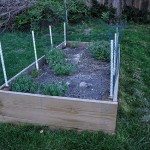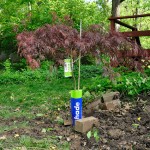With the growing return to gardening during this economic downturn, there are a lot of people who not only want to save money by gardening but save money WHILE gardening. There are quite a few ways to do this. Here are my Top 10:
1. Shop Twice: No, this isn’t a riddle, shop twice. Make your first trip purely exploratory. Leave your wallet in the car, take a notebook and your camera and research the different plants and prices your local nurseries have. Return home (empty handed) and then plan where each and every thing will go and how much you’ll need to fill the space or yield what your family will use. Then return to the stores that had the lowest prices on those items and buy.
2. Plant Perennials and bulbs: Not only a great way to enjoy effortless yield every year but a great way to save money. An additional perk is that these perennials often appear before planting season, so you’ve got new growth and usable herbs before anyone in the neighborhood. Many herbs can also be grown indoors during the winter, giving you fresh flavors for your cold-weather meals.
3. Compost and Make Your Own Soil: A great way to not only reduce household trash waste, but invigorate and build healthy soil for gardening; reducing the amount of chemical fertilizers and store bought soil necessary to grow plants. Save all the food scraps except fatty, greasy or bony things, and bury them in an area of the garden. You can use coffee grounds, eggshells, peels, bread crusts, all of it. When you’re ready to plant, bury them just out side the drip line of the plant. That way, by the time it has broken down the plant will be growing into that spot. (The drip line is the outside edge of a plant, looking down on it.)
reducing the amount of chemical fertilizers and store bought soil necessary to grow plants. Save all the food scraps except fatty, greasy or bony things, and bury them in an area of the garden. You can use coffee grounds, eggshells, peels, bread crusts, all of it. When you’re ready to plant, bury them just out side the drip line of the plant. That way, by the time it has broken down the plant will be growing into that spot. (The drip line is the outside edge of a plant, looking down on it.)
4. Free Compost: No, I’m not repeating myself. Our local utility has to prune trees constantly to keep them away from the electrical lines and unwanted areas, and they will give you a huge dump truck load of wood chips free, just for the asking. If you can’t use them all, you can share with the neighbors. Most municipalities have waste reduction laws they are working under, that involve diverting a certain percentage of the waste stream out of the landfills, and into recycling, or COMPOSTING.
5. Free Fertilizers: Our local county office the country collects a diverse variety of discarded chemicals people turn in, and they will give it to you if you want to use it. Old paint, garden chemicals, etc. Also, home and garden shows often have manufacturers who are handing out samples. They work just fine. You can also make a lot of simple fertilizers and insect deterrents in your own home.
- Soap sprays deter aphids (3 T. Ivory Snow or Fels Naptha to 1 gl. water)
- A few cloves of garlic crushed in some water and sprayed on pests
- A dusting of diatomaceous earth controls aphids also
- Use crushed eggshells around tender plants to kill slugs and fertilize your soil at the same time
6. End of Season Sales: Many nurseries, and especially grocery stores, sell their container stock cheap to get ready for the next season’s plants. That means for a very small investment, you could have the large shrubs for the backbone of your garden. Look especially for great deals on hardy shrubs that can be used as permanant investment and the shape of your garden. Additionally, you can look online for deals and sales on seeds to use for the future. A wise move for planning your vegetables and flowers. Seeds retain their ability to germinate for several years, so make the most of your investment, and store extra seeds in a seed keeper or binder with plastic pages. If you have seeds you don’t think you’ll ever use again, don’t throw them out! Consider looking up community seed trades or ask your neighbor if they would like to trade.
7. Choose low maintenance plants: Some plants are more costly to maintain than others. Many require lots of water, special fertilizer and costly pesticides. Roses are a good example of a high maintenance plant. Make sure that you know what your plants will require before deciding what to plant. Xeriscaping is worth looking into. It is the science of low maintenance landscaping. This does not mean that your yard will be filled with cactus and rocks. There are many vegetables, flowers and shrubs that do well in dry areas.
 8. Make Rain Barrels: A great way to save on your water bill is to save rain water and reuse it on plants when they dry out.
8. Make Rain Barrels: A great way to save on your water bill is to save rain water and reuse it on plants when they dry out.
9. Pine Needle Mulch: If you have access to Pine Needles, they make excellent and less costly mulch. They are also a great way to reuse something that occurs naturally.The needles of pine trees as well as shredded cones make an excellent mulch particularly for evergreens and plants that thrive in acidic soils. Pine needle mulch, formerly available only in the southern states, is becoming available in other regions.
10. Keep Your Eyes Out: If your neighbor has a plant you like, ask for a clipping. Maybe they have something you like and you can trade. My aunt has an award winning garden build out of many things she started as “clippings.”
{images via This Old House (rain barrel), and The Hot Potato (composting)}
———————————————————————————————–
Do you have any great garden tips to share?
You may also like







i need to start composting. we’re wanting to make a mini-garden and the soil around our house is red clay mud!
also the hubs bought a rain barrel.
now just to get started! 🙂
We utilize rain barrels made out of old food grade 50 gallon barrels. Scrub them out, disinfected them and hooked them up. Favorite tool in the summer.
Our neighborhood started a plant swap so in mid-May at the local park all the neighbors come and bring in their plants and trade with each other. The extra plants that don’t find a home are used to beautify the park. It’s a neat program and it’s great to build community and it was fun seeing a plant from my garden go to use at the park.
Great tips, I really want to get a rain barrel.
Great post. We are getting ready to make our own rain barrell. Pretty excited about that!